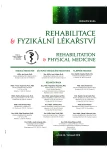Is the Stationary Bicycle a Suitable Supplement of Physiotherapy in Vertebrogenic Difficulties?
Authors:
J. Čuj 1,2; M. Gajdoš 1,2; W. Mikuľáková 1; M. Jurčišin 1; B. Kračmar 2
Authors‘ workplace:
Katedra fyzioterapie, Fakulta zdravotníckych odborov, Prešovská univerzita v Prešove
1; Katedra športov v prírode, Fakulta telesnej výchovy a športu, Univerzita Karlova, Praha
2
Published in:
Rehabil. fyz. Lék., 26, 2019, No. 4, pp. 198-204.
Category:
Original Papers
Overview
Basis and objective: Cycling in all its forms is presently in this country and in the world one of the most frequently performed motion activities. The stationary bicycle is often used as a supplement of physiotherapy is various vertebrogenic difficulties, but also after surgeries on the axial system. However, is the stationary bicycle a suitable supplement of rehabilitation is damages of human axial apparatus?
Methods and cohort: For collection of objective data the authors used a noninvasive diagnostic system SonoSens Monitor. After sticking the electrodes on precisely specified positions on the respondent’s body, the authors execute two 10-minute intervals of cycling on the stationary bicycle. The observed group employed health individuals of both sexes at the age of 23±2 years, height 170±10 cm, weight 75±10 kg and BMI in the range of 17 to 25.
Results: Based on the evaluation of individual measurements the authors recorded most conspicuous deviations from reference values in respondents’ riding the stationary bicycle in sagittal plane with all sections of the spine, which is also documented by the level of statistical significance p<0. 005.
Conclusion: the results made it obvious that riding on the stationary bicycle is not a suitable supplement of physiotherapeutic treatment of vertebrogenic difficulties.
Keywords:
Physiotherapy
Sources
1. BURNETT, A. F.: Spinal kinematics and trunk muscle activity in cyclists: A comparison between healthy controls and non-specific chronic low back pain subjects-A pilot investigation. Man Ther, 9, 2004, 4, s. 211-219.
2. ERICKSON, M. O. et al.: Power output and work in different muscle Gross during ergometer cycling. Eur. Appl Physiol., 55, 1986, 3, s. 229-235.
3. FRIEL, J.: Tréninková bible pro triatlonisty. 1. vyd., Praha, Mladá fronta, 2014, 416 s.
4. GÚTH, A.: Bolesť a škola chrbtice. Bratislava, LIEČREH, 2017, 128 s.
5. HNÍZDIL, J.: Bolesti zad: mýty a realita. 1. vyd., Praha, Triton, 2005, 232 s.
6. JANEČKOVÁ, P.: Nejčastější zdravotní obtíže u horských cyklistů: diplomová práca. Praha, Univerzita Karlova, Fakulta tělesné výchovy a sportu, 2011, 71 s.
7. JEBAVÝ, R.: Komparace silových cvičenína na nestabilních a stabilních plochách jako prostředek pro zlepšení činnosti hlubokého stabilizačního systému. Rehabilitácia, 53, 2016, 2, s. 93-102.
8. KRAČMAR, B. a kol.: Fylogenetické aspekty lidské lokomoce. Rehabilitácia, 54, 2017, 1, s. 61-76.
9. KRAČMAR, B. a kol.: Fylogeneze lidské lokomoce. 1. vyd., Praha, Univerzita Karlova, Karolinum, 2016, 464 s.
10. KRAČMAR, B.: Vliv cyklistiky na pohybovou soustavu. Rehabil. fyz. Lék., 12, 2005, 1, s. 27-33.
11. LANDA, P.: Cyklistika. 1. vyd., Praha, Grada Publishing, 2005, 128 s.
12. MARSDEN, M.: Lower back pain in cyclists. International SportMed Journal, 11, 2010, 1, s. 216-225.
13. NECHVÁTAL, P. a kol.: Movement activity and sport for patients after cervical distectomy. Hrvatska Revija za Rehabilitacijska Istraživanja, 51, 2015, 1, s. 71-76.
14. SALAI, M. et al.: Effect of changing the saddle angle on the incidence f low back pain in recretional bicyclist. Br. J. Sports Med., 33, 1999, 6, s. 398-400.
15. SOVNDAL, S.: Cyklistika - anatómia. 1. vyd., Bratislava, CPress, 2018, 199 s.
16. SRINIVASAN, J.: Low back pain andmuscle fatigue due to road cycling: An EMG study. J. Bodyw Mov. Ther., 11, 2007, 3, s. 260-266.
17. WILBER, C. A.: An epidemiological analysis of oveuse injuries among recreational cyclist. Int. J. Sports Med., 16, 1995, 3, s. 201-206.
Labels
Physiotherapist, university degree Rehabilitation Sports medicineArticle was published in
Rehabilitation & Physical Medicine

2019 Issue 4
- Hope Awakens with Early Diagnosis of Parkinson's Disease Based on Skin Odor
- Deep stimulation of the globus pallidus improved clinical symptoms in a patient with refractory parkinsonism and genetic mutation
Most read in this issue
- Application of the Concept of Auto-Reflex Connection of Deep Stabilization System after Surgery on Hernia of Intervertebral Disc in Lumbar Spine Treatment of Multiple Sclerosis from the Point of View of Rehabilitation
- Biofeedback and Its Application if Therapeutic Rehabilitation of Human LocomotorSystem
- Is the Stationary Bicycle a Suitable Supplement of Physiotherapy in Vertebrogenic Difficulties?
- The Influence of Training on Maximum Performance and Shoulder Pain in Flatwater Kayak-Paddlers
